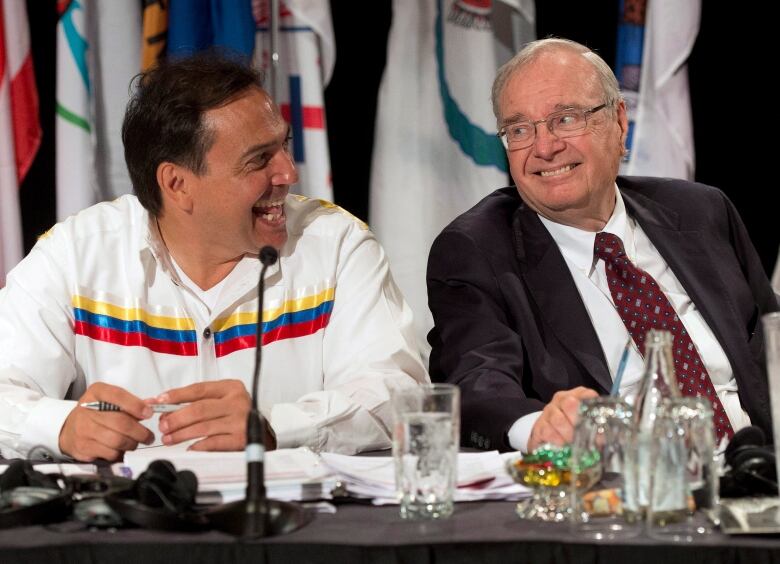Cap leads to steep drop in First Nations students receiving post-secondary support
Number of Indigenous students receiving federal support for higher education has dropped 18.3% since 1997

The federal program that helpsFirst Nationsand Inuit peopleattend college or university has registered an 18.3 per cent declinein the number of students it funds since 1997,according to documents obtained by the NDP through Access to Information and shared with CBC News.
The slump is striking given the population growth in those communities over the same time period. (TheFirst Nations population alone has grown 29 per cent since 1997.)
But a Liberal campaign promise to add $50 million a year to thepost-secondary student support program forIndigenous students was not included in the spring budget, adding to the funding crunch.
"I'm shocked and saddened to see those numbers. Ididn't realize it was that high,"Assembly of First Nations NationalChief Perry Bellegarde said in an interview with CBC News. "We've had 10,000 students on the wait listfor years, trying to access post-secondary institutions.
"More and more graduates are coming out of Grade 12 and you're telling First Nations students: 'No. No you can't go to university. Your right toeducation isbeing capped.' This is not acceptable. It's just another missedopportunity to helpclose the socioeconomic gap that exists."
- Debunking the myth that all First Nations people receive free post-secondary education
- First Nations child advocate waiting for Ottawa to end racial discrimination
- Federal documents point to funding problem in Aboriginal student fund
The student support programhas stagnated since former finance minister Paul Martin imposed a two per cent annual cap on spending increases at the Department of Indigenous Affairs in the1990s as part of an effort to rein in mounting budget deficits.
The average price of tuition, however, has more than doubled since that cap was imposed.In Ontario, inflation-adjusted fees were roughly $4,000 in 1996-97and have surged to $8,691 in 2016-17according to the Canadian Centre for Policy Alternativesmeaning the pool of funds available to First Nations students has failed to keep pace with inflation and the rapidly rising cost of tuition.
When presented with her department's own data, Indigenous Affairs Minister CarolynBennett said she would like to see thenumber of First Nations students that are heading to university or college for the first time this week when classes return.
"I'm looking forward not back.There was a time kids had lost hope and couldn't seethemselves in post-secondary, and I think we're turning that around," the minister said in an interview. "We're really seeing an exciting take-up."
Liberals break 1st election promise
Charlie Angus, the NDP's critic for Indigenous affairs, said there will be no meaningful growth in the number of First Nations students seeking a post-secondary education until the cap is lifted.
"Indigenous communities have been crippled by the two per cent cap. What disturbs me is that it is so difficult for many Indigenous students to graduate from schools in isolated communities. The young people who want to gothey're being denied the support they need. We're abandoning the potential of this next generation and it's really unconscionable," he said.

Thesupport programis designed to help offset tuition, books, travel and living costs, and to fulfil the federalgovernment's treaty obligation to provide status Indians with education.
The maximum non-repayablegrant is $35,000 a yearalthoughfew actuallyreceive that full amount and approximately 22,000 students receive some funds from the program each year.Funding for certain programs islimited and not all prospective students get help, even if they have the grades.
'Heartbreaking' choices
The first spending promise Liberal Leader JustinTrudeaumade during the last campaign was a $2.6-billion boost to First Nations education spending for kindergarten to Grade 12 and $50 million more annually for the post-secondary support program."We will make up for 10 long-lost years,"Trudeausaid in August2015.But the 2016 budget was silent on the funding for post-secondary education.
"Why was that promise considered breakable? It sends a very, very bad message to all Indigenous youth," Angus said."They made a promise for tax cuts for people earning $200,000 a yearand they delivered. They made a promise to Indigenouschildren and they didn't deliver. It's a question of priorities."
The decision is further proof the federal government is "all talk" on the issue of First Nations education, the national chair for the Canadian Federation of Students said in an interview.
"It's very shameful,"BilanArte said."Let's see the money. Let's actually commit not just through words but through funding."
Let's rectify this wrong.A good education is the best way out of poverty.- AFNGrand Chief Perry Bellegarde
Band or tribal councils, which distribute money from the support program, are forced to make "heartbreaking" choices about which students will be eligible, she said.
Now, many prospectivestudents willhave to wait until next fall to pursue a university or college degree with the hopethe government will come through on its promises.
Bellegardesaid advocates have to refine their pitch to the Liberal government.
"Let's make sure that this is on everybody's radar," he said of pre-budget planning, which will begin this fall. "Let's rectify this wrong.A good education is the best way out of poverty and thisis about investing in human capital."
Bennett left the door open to fulfilling the Liberal campaign promise down the line, but did not say definitively why the funding was left out this year.
"These budgets get written in a certain way and we're just working towards the next budget. It's still a commitment. It was in our platform," she said.

She also pointed to the $8.6 billion in new funding the government directed towardIndigenous peopleoverall.
"I think thatwas pretty historic investment, and I think that coast to coast to coast it was extremely well-received. [First Nations] know that everything isn't done in the first year."













_(720p).jpg)


 OFFICIAL HD MUSIC VIDEO.jpg)
.jpg)



























































































